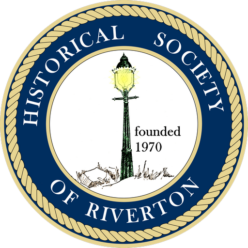Anyone who collects RPPCs, short for “real photo post cards,” knows that while they may offer some of the most unusual and rare views, we often come up empty-handed at the end of bidding. So it is with special gratitude to our friend of the HSR, Harlan Radford, we offer these scans of Camden postcards along with his annotations.
We also acknowledge the contribution of historian Paul W. Schopp for his expertise and advice which resulted in this expanded commentary.Click on images for enlarged views.
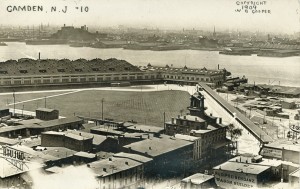
CAMDEN, NJ RPPC #10 1909: This 1909 unmailed real photo post card depicts the Pennsylvania Railroad Terminal at Federal and Market Streets in downtown Camden. Built in 1899, it consists of an overhead covered train shed enclosing all railroad tracks, two Public Service Electric Railway (trolley) loops, and four ferry-boat slips to connect with Philadelphia on the other side of the Delaware River. The prominent structure in the lower right foreground is the West Jersey Hotel. Constructed in 1850, and designed by Walt Whitman’s next-door neighbor, Stephen Decatur Button and his brother-in-law, Joseph C. Hoxie, it survived into the twentieth century, becoming the Hotel Ridgway.
This is one of a series of 11 postcards captured by Medford post card photographer William B. Cooper from the top of the Victor Talking Machine Company’s smokestack in the summer or fall of 1908 and copyrighted in 1909.
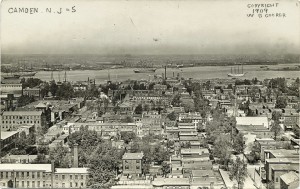
CAMDEN, NJ RPPC #5 1909: This real photo post card, copyright 1909, postmarked Feb. 26, 1909, looks towards Coopers Point, the site of the Camden & Atlantic Railroad’s ferry and train terminal and numerous shipyards. Close examination reveals a neighborhood with row houses, small businesses, and churches. Sailing ships with three, four, and six masts anchored on the Delaware River wait to receive or discharge cargo. Toward the center left of the image is an Italianate house known as Cooper’s Folly, which was unceremoniously razed in 1924.

CAMDEN, NJ RPPC #6 1909: For this real photo post card view, copyright 1909, mailed and postmarked at Camden on Feb. 15, 1909, Cooper swung the camera a little bit more east from view #5, showing more of North Camden. It illustrates part of East Camden, N.J. and looking northeast to Cramer Hill. The church spire on the right is the First Presbyterian Church at 5th and Penn Streets. Cramer Hill was one of Camden’s several up and coming housing developments. Builder Alfred Cramer was known for his construction of single-family dwellings, stores, as well as tidy brick row houses, which were more affordable for Camden’s growing workforce. In the background towards the left is the Camden Woolen Mills, completed in 1866.
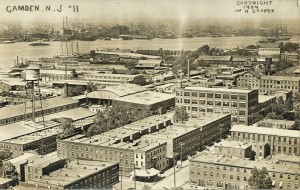
CAMDEN, NJ RPPC #11 1909: Another in the remarkable series of W.B. Cooper aerial views of Camden, this unmailed real photo post card view shows a part of downtown Camden, N.J. This image looks north/northwest toward Cooper’s Point Ferry with a Campbell Soup warehouse and various factories in the foreground and the Delaware River in the background. This sweeping outlook includes several sailing ships, many businesses, factories, warehouses, and wharves. Many large and noted manufacturing companies began to call Camden their home at this time. These panoramic aerial photos give unobstructed views of the then-thriving City of Camden from several directions.
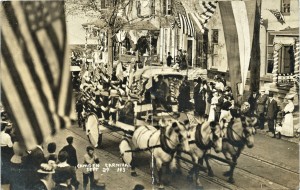
RPPC CAMDEN CARNIVAL RPPC 1908: The subject of this real photo post card is a Camden Carnival on a residential street occurring Sept. 29, 1908. Sponsored by the Camden Business Improvement Association, the four-day celebration was held September 29, 30, and October 1, 1908. The decorated 3-horse-drawn wagon in the foreground is the center of attention. Patriotic bunting and an abundance of American flags adorn the homes. Many spectators bedecked in their finery view the parade and enjoy this celebratory occasion back in the first decade of the twentieth century!
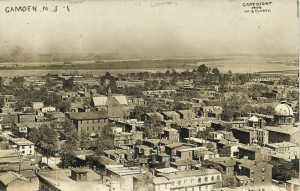
Next follow three more Camden images, and while they are already in the Camden Images Gallery, these have descriptions and are displayed in higher resolution here.
CAMDEN, NJ RPPC #1 1909: Looking north from center Camden, note the dome of the North Baptist Church on the far right; Tabernacle M.E. Church is the large structure near the center; in the Delaware River in the distance lies 292-acre Petty Island (commonly called Petty’s Island).

CAMDEN, NJ RPPC #7 1909 : This real photo post card depicts the business center of Camden. The sender of this post card has marked four specific buildings and numbered them as 1, 2, 3, & 4. The domed building on the left marked as #1 is the County Court House, erected in 1905-06, at a cost of $800,000. Building #2 is the Third Regiment Armory. Structure #3 is Camden High and Manual Training School. City Hall on Haddon Avenue is #4. In addition, the building in the left foreground is the Security Trust Company building, designed by local architect Arthur Truscott, which sits at southeast corner of Third and Market streets. At the extreme left center is the Cathedral of the Immaculate Conception, built in 1866 and designed by ecclesiastical architect Jeremiah O’Rourke who later became the architect of the Capitol. According to the sender of this card, “This is a view of part of Camden taken from the New Victor Chimney.”
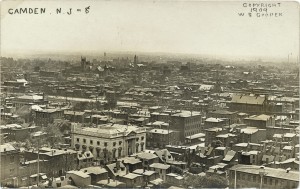
CAMDEN, NJ RPPC #8 1909: The U.S. Post Office at Third and Arch Streets, which also served as the federal courthouse, stands in the left foreground of this view of downtown Camden. Running through the center of this image is the recently completed elevated trackage of the West Jersey & Seashore’s third-rail electric line to Millville and to Atlantic City. High-speed rail at its finest! In the center right is the old Third Street Methodist Church that later became the PRR YMCA. During Walt Whitman’s time in Camden, he would frequently complain about the choir from this church! On the extreme left center, you can see the South Jersey Gas, Electric & Traction Company office building, which still stands today along Federal Street. It is a wonderful example of a Beaux Arts office building. In the distance is the steeple of First Methodist Church, which Cooper Hospital demolished within the last ten years. This image certainly captures the vitality and the steady growth that Camden experienced in the beginning of the last century.
PS: Links connect to other images in the collection, although not necessarily from the same era. For example, the postcard showing the RCA Building also shows the Delaware River Bridge, now re-named the Benjamin Franklin Bridge, which did not open until 1926.
Can you help us further to “connect the dots” by giving to the Society any scans for this or another category in our online image collection? Would not all eleven of William B. Cooper’s post cards shot from the top of the Victor Talking Machine Company’s smokestack be something to see in one place? It would be an expensive and time-consuming task for an individual, but certainly an achievable goal if others viewing this can contribute.
If you have any actual South Jersey or Jersey Shore postcards, photos, ephemera, or collectibles you would like to give to the Society please contact us. Either way, we are glad to add your collection to our virtual archive so all may enjoy and learn from them. – JMc
